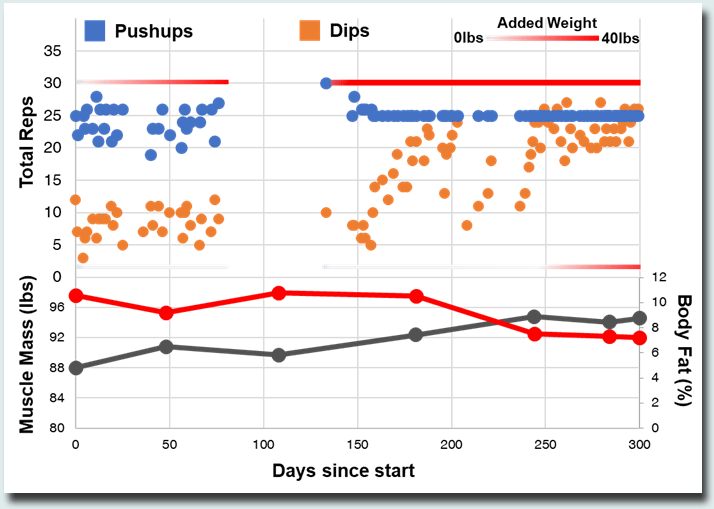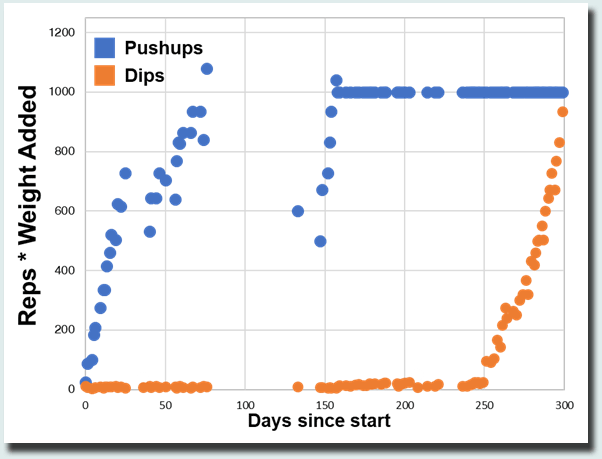
Purpose: Many have proclamated the need for 30 minutes a day of moderate exercise - 5 days a week in addition to a lengthy strength training session for optimal health. In the real world nobody does that. In this experiment, Scientific AmeriKen explores if just a little bit of exercise can help. Specifically, using body weight exercises (push-ups and dips), can 3-5 minutes every day or so build strength and muscle mass. If successful, this body of work will lay the foundation for even shorter exercise strategies.Hypothesis: If a lot of something is good, then maybe a little is good too. The hypothesis of this experiment is that it will work.
Materials and Methods: Needed for this experiment is a push/pull/dip bar and a weight vest. The strategy used was starting with pushups to exhaustion, taking 20-30 second rest, then doing dips to exhaustion, 20-30 seconds rest then doing chin-ups to exhaustion. For the first ~60 days of the experiment this strategy was repeated after 5 minutes rest (two sets), but only a single set thereafter. Also, exercises were initiated with no weight in the weight vest. Once 25 or more reps were achieved in any exercise then 4lbs was added to the vest during that exercise. Additionally, once push-ups hit 25 reps at 40lbs, then total reps were capped at 25 regardless of potential to do more. Exercises were performed every 1-3 days. Body composition was performed using an InBody body analyzer. In full disclosure, other activities including pickleball, tennis, and softball and occasional running were performed at random times. Finally, for simplicity, pull-up data was not included.
Results: The experiment lasted over nearly 300 days. From days roughly 60-120 an alternative strategy was used (dips then pushups) - but this data was not included. Chin-ups remained relatively even throughout the experiment (~7-10 reps / day). Each set (Pushups, dips, then chin-ups) took approximately 3-4 minutes to complete. For the first 60 days two sets were performed, from then on only 1 set. Figure 1 initially shows an increase in the amount of weight during pushups, while dips remain consistent. Once pushups were capped at 25, dips then increased reaching 25 with 40lbs on day 300. Body composition (Figure 1 lower half) shows increasing muscle mass and lower body fat during this time. In Figure 2, the increasing intensity arising from added weight on the vest is made more apparent by multiplying the amount of reps performed by the weight in the vest.

Figure 1. Increasing reps for pushups (blue dots) and dips (orange dots) per day. White to red gradient bar represents the amount of weight on vest for that day with the top bar for pushups and bottom bar for dips. Body composition was measured periodically with the red line representing body fat % and the black line muscle mass.

Figure 2. These data represent daily reps multiplied by the weight on the vest.
Discussion/Conclusion: Amazingly with just 3-4 minutes per day, ScientificAmeriKen made significant gains in muscle mass (about 5 lbs) and lost body fat (about 2.5%). The key to this success was playing the long game - taking nearly 1 year to accomplish. Perhaps the true key to success when it comes to exercise is just be consistent. Certainly, there is more factors in this N=1 experiment to consider, perhaps it was the pickleball - a clinically addictive sport for which ScientificAmeriken is considering going pro. Also, diet may be a factor, this has generally remained unchanged through this year trending towards a mix of fresh fruit, prestine green salads, legumes, organic mixed nuts, mountain spring waters, and tons of junk food. In total, this experiment demonstrates the power of incremental change as a result of a few minutes a day. Future experiments will examine if even less can still get the job done!